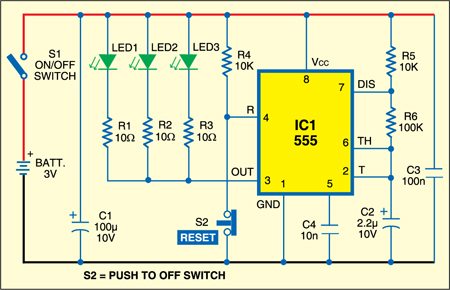 Here is a simple green LED flashlight built around a 555 timer IC (IC1) and powered from a 3V battery pack.
Here is a simple green LED flashlight built around a 555 timer IC (IC1) and powered from a 3V battery pack.
Green LED-based flashlights are widely used by hunters and others in similar activities to light up their way and alert other hunters of their presence. The colour green does not interfere with the hunt, as animals are blind or indifferent to green light. Green is also a good night-vision retention colour that allows one to distinguish colours such as yellow and red on maps and charts.
Green LED flashlight circuit
Key component of this flashlight is a 555 timer (IC1) that is configured as an astable multivibrator generating a 50 per cent duty cycle square wave at approximately 6Hz frequency. Three 5mm green LEDs (LED1 through LED3) are connected at output pin 3 of IC1. Resistors R1 through R3 limit the current through the LEDs to prevent them from burning up.
Switch S1 is the main on/off switch. In normal mode, IC1 is disabled by a normally-closed (N/C) push-to-off switch S1, keeping its output low. As a result, all LEDs (LED1–LED3) glow continuously. On the other hand, when S2 is depressed, IC1 is enabled, and all LEDs start flashing at approximately 6Hz frequency.
You can also use this flashlight like a signal lamp. Flashing frequency can be varied by changing the value of capacitor C2.
The entire circuit can be easily assembled on a general-purpose PCB and enclosed in a small plastic box. Drill suitable holes for LEDs and switches. Finally, attach the battery holder using a double-sided glue tape.
EFY note
After looking at a bright light source, you may continue to see an image of that source when you look away. This lingering visual impression is called an afterimage and fades over time.
If you use a very bright flashlight, the afterimage overlaps your field of vision and makes it hard for you to see until the afterimage fades. White light containing all frequencies, from red all the way to violet (the visible light spectrum), will ruin your night vision capacity.
Red is favoured when you need to recover quickly, while green should be used for acuity. So try using a green light source.
The article was first published in July 2010 and has recently been updated.









it’s simulation is not working on multisim…please help !!!
WHAT is the use of it.
in what conditions does the does the s2 gets depressed .
please help me in this question.
You can use it as torchlight or signal lamp. Depending on the situation and requirement you can press S2 at any time.